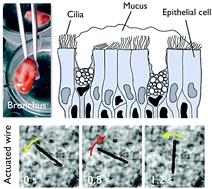当前位置:
X-MOL 学术
›
Soft Matter
›
论文详情
Our official English website, www.x-mol.net, welcomes your
feedback! (Note: you will need to create a separate account there.)
Magnetic wire active microrheology of human respiratory mucus
Soft Matter ( IF 2.9 ) Pub Date : 2021-07-28 , DOI: 10.1039/d1sm00512j Milad Radiom 1 , Romain Hénault , Salma Mani , Aline Grein Iankovski , Xavier Norel , Jean-François Berret
Soft Matter ( IF 2.9 ) Pub Date : 2021-07-28 , DOI: 10.1039/d1sm00512j Milad Radiom 1 , Romain Hénault , Salma Mani , Aline Grein Iankovski , Xavier Norel , Jean-François Berret
Affiliation

|
Mucus is a viscoelastic gel secreted by the pulmonary epithelium in the tracheobronchial region of the lungs. The coordinated beating of cilia moves mucus upwards towards the pharynx, removing inhaled pathogens and particles from the airways. The efficacy of this clearance mechanism depends primarily on the rheological properties of mucus. Here we use magnetic wire based microrheology to study the viscoelastic properties of human mucus collected from human bronchus tubes. The response of wires between 5 and 80 μm in length to a rotating magnetic field is monitored by optical time-lapse microscopy and analyzed using constitutive equations of rheology, including those of Maxwell and Kelvin-Voigt. The static shear viscosity and elastic modulus can be inferred from low frequency (3 × 10−3–30 rad s−1) measurements, leading to the evaluation of the mucin network relaxation time. This relaxation time is found to be widely distributed, from one to several hundred seconds. Mucus is identified as a viscoelastic liquid with an elastic modulus of 2.5 ± 0.5 Pa and a static viscosity of 100 ± 40 Pa s. Our work shows that beyond the established spatial variations in rheological properties due to microcavities, mucus exhibits secondary inhomogeneities associated with the relaxation time of the mucin network that may be important for its flow properties.
中文翻译:

人呼吸道粘液的电磁线活性微流变学
粘液是由肺气管支气管区域的肺上皮分泌的粘弹性凝胶。纤毛的协调跳动将粘液向上移向咽部,从气道中清除吸入的病原体和颗粒。这种清除机制的功效主要取决于粘液的流变特性。在这里,我们使用基于磁线的微流变学来研究从人类支气管收集的人类粘液的粘弹性。长度在 5 到 80 μm 之间的导线对旋转磁场的响应通过光学延时显微镜进行监测,并使用流变学本构方程进行分析,包括 Maxwell 和 Kelvin-Voigt 的本构方程。静态剪切粘度和弹性模量可以从低频(3 × 10 -3 –30 rad s -1) 测量,导致对粘蛋白网络弛豫时间的评估。发现该弛豫时间分布广泛,从一秒到几百秒不等。粘液被确定为一种粘弹性液体,其弹性模量为 2.5 ± 0.5 Pa,静态粘度为 100 ± 40 Pa s。我们的工作表明,除了由于微腔引起的流变特性的既定空间变化之外,粘液还表现出与粘蛋白网络弛豫时间相关的二次不均匀性,这可能对其流动特性很重要。
更新日期:2021-08-03
中文翻译:

人呼吸道粘液的电磁线活性微流变学
粘液是由肺气管支气管区域的肺上皮分泌的粘弹性凝胶。纤毛的协调跳动将粘液向上移向咽部,从气道中清除吸入的病原体和颗粒。这种清除机制的功效主要取决于粘液的流变特性。在这里,我们使用基于磁线的微流变学来研究从人类支气管收集的人类粘液的粘弹性。长度在 5 到 80 μm 之间的导线对旋转磁场的响应通过光学延时显微镜进行监测,并使用流变学本构方程进行分析,包括 Maxwell 和 Kelvin-Voigt 的本构方程。静态剪切粘度和弹性模量可以从低频(3 × 10 -3 –30 rad s -1) 测量,导致对粘蛋白网络弛豫时间的评估。发现该弛豫时间分布广泛,从一秒到几百秒不等。粘液被确定为一种粘弹性液体,其弹性模量为 2.5 ± 0.5 Pa,静态粘度为 100 ± 40 Pa s。我们的工作表明,除了由于微腔引起的流变特性的既定空间变化之外,粘液还表现出与粘蛋白网络弛豫时间相关的二次不均匀性,这可能对其流动特性很重要。











































 京公网安备 11010802027423号
京公网安备 11010802027423号